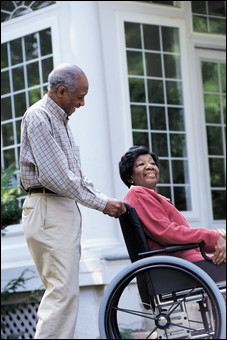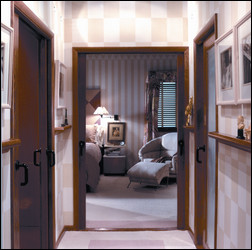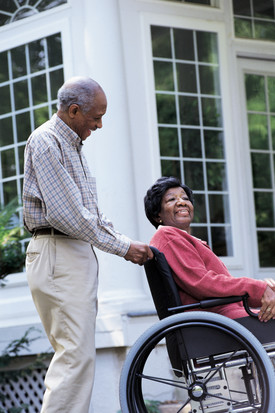As a nation, we’re getting older. Harvard University’s Joint Center for Housing Studies says 20 percent of the U.S. population will be classified as elderly by the year 2030.
 Planning for the different stages of life makes aging-in-place a wonderful and viable option for homeowners who love their homes. |
As we age, it becomes more of a challenge to do the simple things, like open a can if you have arthritis. When a smart product designer developed the automatic can opener, the problem was solved.
All-Inclusive Design
It’s the same with universal design. It’s all about convenience, accessibility and the ability to stay in our homes—otherwise known as “aging in place”— which is made possible by a few alterations in layout and design. In the last decade, aging in place has not only become the most desirable way of aging, but it is also the most cost-effective way.
Universal design is a concept born out of the Americans with Disabilities Act of 1990 to accommodate as many people as possible, regardless of age, size or ability.
Ron Mace, who uses a wheelchair, is an architect who created the term “universal design.” In 1989, he established the Center for Universal Design at the School of Design at North Carolina State University in Raleigh.
In residential design, universal design means a home that works as well for a 4’8″ wife as her 6’5″ husband, a person using a wheelchair, a senior or someone dealing with a temporary physically challenge.
Take the simple doorknob. Not everyone can twist its round shape. The solution: lever handles that are easier for most people to press down.
“I want my home to have lever door handles when I have two bags of groceries in my arms,” says Bruce Goff, a member of the American Society of Interior Designers (ASIDP) and principle of Domus Design Group in San Francisco and Reno. “It’s simple—I need to open the door,” Goff says, which he can’t do without putting down his groceries. However, with a universal design lever door handle it would be possible. “Everyone needs to be comfortable and safe in their own environment,” he says.
For example, if you’re 30 years old, in good physical shape and healthy, your house works for you now. But later, you might feel locked out of your house if you break a leg, need a wheelchair and can’t reach the sink in the bathroom. And here’s something else to think about: In 30 years, you’ll be 60, and it won’t be so easy to search for a favorite baking pan in the kitchen cupboard when you have to get down on the floor.
In the design world, “people erroneously assumes that everyone is a healthy and agile, 25-year-old male,” confides Goff. But the truth is, one size doesn’t fit all. When designing homes, home products or furniture using the standards of user-friendly universal design, the configuration should work for everyone.
 Pocket doors can easily slide out of the way with one arm motion. Photo courtesy of Johnson Hardware. |
Features of Universal Design
“Universal design shouldn’t be a specialty—it should just be the way design is,” explains Bernadette V. Upton, ASID, LEED and owner of EcoDecor in North Palm Beach, Fla.
“The elderly need five to seven times more light than a 30-year-old person,” she says. So, getting enough daylight into a house becomes an important health factor in the design equation as older people can become vitamin D deficient.
Individual homeowners can take a few simple steps toward universal design without great expense. Slips and falls happen. To guard against them, use non-skid mats underneath area rugs. Non-slip cork flooring in the kitchen has an added benefit that includes less back strain on the cook standing at the counter.
Drue Ellen Lawlor, Fellow American Society of Interior Designers (FASID) and chair of ASID’s National Aging in Place Council in San Gabriel, Calif., gives the following examples of features to look for in universal design:
• At least one stepless entry into the home
• Multiple-height kitchen countertops for tall, short or seated cooks
• “D” or loop hardware for easier access by those with limited hand mobility
• Double sinks in master bath at different heights for seated and standing users
• Curbless shower for ALL users to avoid tripping
• All doors at least 36 inches wide with an opening of at least 32 inches
• Hallways at least 36 inches wide
• At least one accessible bathroom and a bedroom on main level
• No thresholds or reduced height of thresholds
• Pocket doors with good hardware where possible
• Handheld shower, seat in shower and transfer space next to toilet
• Grab bars in all bathrooms for all ages and abilities
• Cabinets with pullout shelves to reduce stooping
• Appliances with easy-to-reach and easy-to-see controls
“Changes to the bathroom are key when using universal design,” says Lawler. The bathroom is the room that can force someone from his or her home or cause problems recuperating from surgery, an injury or a physical challenge.
Mobility is impacted by the different rooms in a home. The bedroom and living room should have sufficient access and turnaround space for walkers or wheelchairs. Closets should have adjustable closet rods, accessible shelving and adequate lighting. Open access between the kitchen and living area provides a clear sight line that’s good for all stages of life. When designing the entryway, consider installing a package shelf or seat near the door for homeowners of all ages. It’s safer to empty one’s arms or sit when taking off boots or shoes. Add an automatic sensor light focused on the front-door lock to provide safe entry.
 Hot Stop Scald Prevention tub spout and showerhead. Photo courtesy of American Valve. |
Trend Setting
The biggest trend, Goff says “is the fact that universal design is losing its uniqueness as clients now ask for it by name. You can find it at Home Depot, too.”
He’s started a movement with his own clients by asking them to do a home audit of the things that irritate them about their house or diminish quality of life. This information helps uncover problems so they can be resolved with the help of universal design principles.
Those cramped mid-century bathrooms are no longer in vogue. Lawler says luxury walk-in bathtubs along with curbless glass showers will become a much more important trend, especially for baby boomers. And the bonus of a glass shower is it expands the visual space and style of this important room.
In the kitchen, Lawler says the Dacor Microwave-In-A-Drawer is accessible to everyone and the Viking Portable Induction Cooktop makes mealtime easy and possible for everyone because of its flexible placement on a counter, a low table or even outdoors.
“I think the trend toward universal design is truly creating more of a positive approach rather than a negative one” since universal design was thought to be clunky and only needed for the disabled, says Upton. “Great Grabz safety bars took the institutional look out of their products. It’s a great-looking contemporary and artsy grab bar created by an interior designer.”
Universal design provides a blueprint for maximum inclusion of all people, irrespective of age, stage or ability.
Credit: Renovate Your World




























